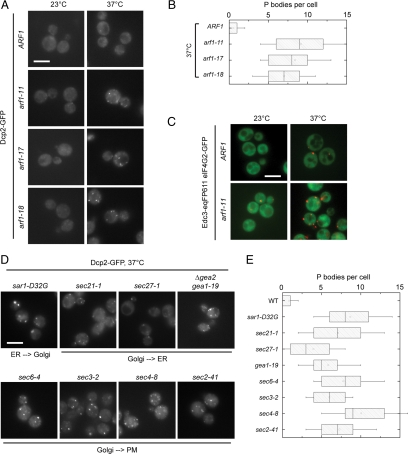Figure 1.
arf1 and secretory pathway mutants have multiple PBs. (A) The PB marker Dcp2 was chromosomally tagged with GFP in the control strain and in several temperature-sensitive arf1 mutants. At the permissive temperature (23°C), no PBs are observed and Dcp2-GFP is dispersed throughout the cytoplasm; upon shift to the nonpermissive temperature (37°C) for 1 h, PB formation is induced in all strains. The increase in PB number is more pronounced in arf1 mutants than in the control. (B) Quantification of the multiple PB phenotype in arf1 mutants at nonpermissive temperature. A minimum of a hundred cells from at least two independent experiments was counted for each condition. The size of the box is determined by the 25th and 75th percentiles; the whiskers represent the 5th and 95th percentiles, the horizontal line and the little square mark the median and the mean, respectively. (C) Wild-type and arf1-11 mutant cells expressing the PB marker Edc3-eqFP611 and the stress granule marker eIF4G2-GFP were shifted to 37°C for 1 h. Although multiple PBs were formed in the arf1-11 mutant, we observed no induction of stress granules in the mutant or the control strain. (D) The number of PBs in different temperature-sensitive mutants in components of the secretory pathway was determined after shift for 1 h to 37°C. All secretory mutants we analyzed displayed a multiple PB phenotype to a varying degree. (E) Quantification of the multiple PB phenotype in secretory mutants after a shift to the nonpermissive temperature. See B for details on the representation. Scale bars, (A, C, and D) 5 μm.

